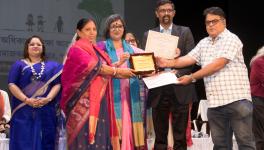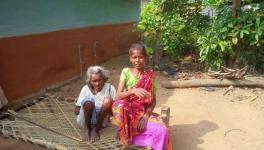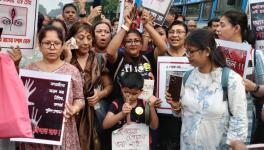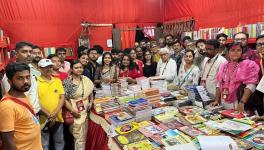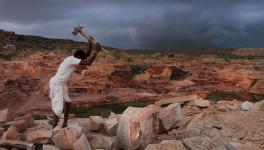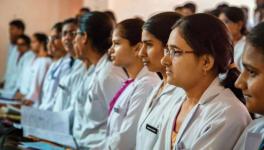Covid-19: Doctors, Healthcare Workers’ Meet the Pandemic Head on
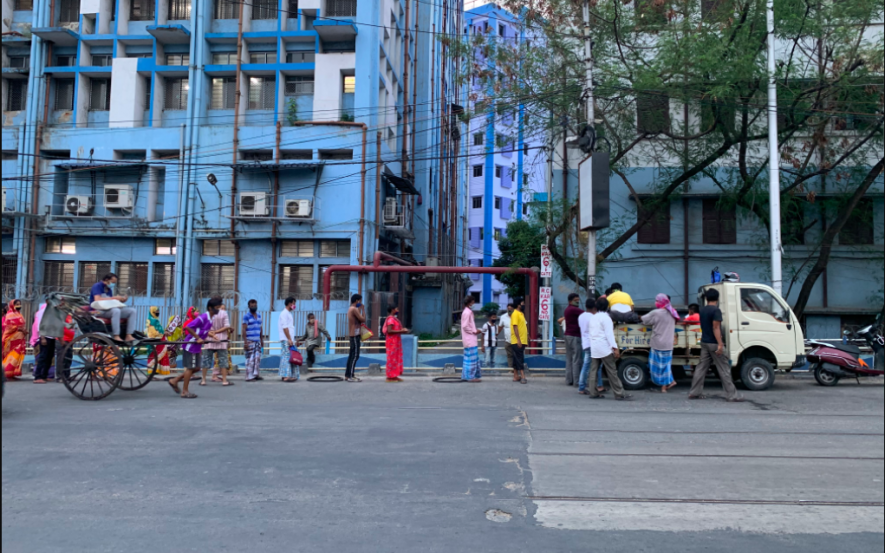
Food being provided near R. G. Kar Medical College & Hospital during Covid-19
Kolkata: For West Bengal’s hundreds of health workers led by doctors, it has been a long haul since the initial Covid-19 days that were marked by uncertainty, chaos, unpreparedness and apprehension. The current situation, after over eight months since the countrywide lockdown was suddenly clamped by the Centre with effect from the midnight of March 24, is best described as one of apparent stabilisation. Medical practitioners and different categories of health workers cannot say for certain that the state will not witness another wave.
This about sums up the observations of doctors and other persons NewsClick spoke to about how they view the developments and the role played by health professionals and workers assigned to treat Covid-19 cases.
On being asked which spell has been the most critical since the pandemic broke out, they are unanimous that the first three months, April-June, had caused utmost concern and proved most challenging. A senior functionary of the state’s Health Department (who did not want to be quoted for reasons of protocol), joint convener of the Joint Platform of Doctors, Dr Hiralal Konar, senior functionary at the stage government’s College of Medicine and Sagar Dutta Hospital (earmarked entirely for Covid-19 treatment), Dr Manas Gumta and Dr Arnab Sengupta of the Institute of Postgraduate Medical Education and Research explained this conclusion.
According to the official of the Health Department which is under the chief minister’s charge, the concern of the health workers was palpable when in the midst of uncertainty, hospitals were earmarked exclusively for Covid-19 cases. Apart from their personal safety in the context of reports that the disease is infectious, they had serious doubts about the availability of Personal Safety Equipment and testing kits. “If you consider how patients are being treated these days, you are bound to infer that what we had then was an apology for facilities. As for medicines, it was difficult to proceed confidently,” he observed.
Dr Konar said a big hurdle was the grossly inadequate knowledge about the disease within the country and abroad. “From the Joint Platform of Doctors, we requested the state government to see that not only doctors but also all categories of health workers engaged in the treatment process had assured supply of PPE. Then, we pleaded for progressive, faster increase in the number of tests. We suggested how other departments should remain functional. Also, we stressed on the importance of total cleanliness within the hospital premises. The situation did not warrant public display of service by sweeping streets as was done by some dignitaries,” he said.
According to Dr Gumta, the country had not seen in the preceding 100 years what was witnessed in the April-June quarter. There was total confusion. While circumstances had warranted “testing, testing and more testing” to detect infections, the preparedness was grossly inadequate. Large-scale training of health workers had to be organised. For us, it was a question of not only saving the lives of the patients, but also their livelihood, he said.
Dr Sengupta pointed out that there was no empirical idea as to which combination of drugs had to be used. Signals about the impending Covid attack were there even before mid-March, but those signals were not taken seriously. It evolved slowly, gathering pace only after five-six weeks. He informed that with due consideration of the similarities, “we took note of the satisfactory post-test experience of Dhaka Medical College of Bangladesh from the use of the very old Ivermectin-Doxycycline combination. Patients administered this combination fared appreciably better than those in the standard of care arm. Eventually, we tried the Ivermectin-Doxycycline combination here”.
Devastation caused by supercyclone Amphan in the latter part of May and return of migrant workers in thousands added to the administration’s problems. Amphan had left 90 people dead and necessitated shifting of several lakh people to rescue centres. The net result: a noticeable spike in Covid-19 cases.
The West Bengal Doctors Forum (WBDF), which is one of the five associations of doctors under the joint platform, was in favour of the strictest restrictions to prevent crowds during Durga Puja days; for it feared a massive surge in infection cases after the event. Not quite satisfied with the approach of the state, it went to the extent of becoming a party to the Public Interest Litigation (WPA 8520 of 2020) in the Calcutta High Court. WBDF pointed out that the medical facilities available within the state are “already stretched to their limits and healthcare professionals and workers are at the point of absolute fatigue and distress. Further, about 60 doctors had succumbed to the attack by then”. [Latest information is that more than 80 doctors have succumbed in the state].
The final directives issued by the division bench comprising Justices Sanjib Banerjee and Arijit Banerjee, which ruled out further relief (selective relaxation followed a review petition). According to informed sources, WBDF’s becoming a party had lent weight to the plea for serious restrictions during the Puja days and the High court’s directives had, as they put it, saved the day.
So, how have the healthcare professionals and workers fared so far? The senior Health Department official told NewsClick, “There were variations in individual performances. But, the point to be noted is that despite their apprehensions about personal safety, particularly after hospitals were identified for treatment of Covid-19 cases alone, they did not run away from the scene. They carried out their assignments and have done fairly well”.
The government hospitals have shouldered the lion’s share of the burden. It is open to doubt as to what extent the private hospitals have supplemented the efforts of the state government. There have been too many complaints about their exorbitant charges and adherence to protocol. “All that I will like to emphasise is that the challenge remains; there is no room for laxity,” Dr Gumta told NewsClick.
According to Dr Sengupta, the positivity rate is down, call rates are down; people have come to know many things about the disease and necessary precautions. “But, it is difficult to vouch for whether there won’t be further waves; the experience of the European countries rules out optimism at this stage,” he told NewsClick.
Mentioning that in districts, Rapid Antigen Tests (RAT) are being conducted in large numbers, he pointed out that as per an advisory of the Indian Council of Medical Research, those testing negative by RAT should be definitely tested subsequently by Real Time Polymerase Chain Reaction (RTPCR) method. A positive should be considered as true positive and does not need confirmation by an RTPCR test. “We have to ensure that the follow-up RTPCR is done for those testing negative. There is a need to be more watchful on this count,” he observed.
From the interactions, however, it is clear that the April-June period was the most difficult, challenging for all the state governments and the reasons are similar.
In the national context, two points need to be mentioned. First, the theme for this year’s Doctors Day, as chosen by the Indian Medical Association, was: “Lessen the mortality of COVID-19”. Secondly, the resident doctors association of the All India Institute of Medical Sciences has demanded setting up of Indian Medical Service, which it called a “much voiced need” for doctors across the country that will be able to bridge the gap between decisions and deliverance.
For the record, it may be mentioned that Doctors’ Day is observed on July 1, which is the birth and death anniversary of former West Bengal chief minister Dr Bidhan Chandra Roy, who was a celebrated physician.
Also read: COVID-19: Good News on the Vaccine Front but Challenges Remain
Get the latest reports & analysis with people's perspective on Protests, movements & deep analytical videos, discussions of the current affairs in your Telegram app. Subscribe to NewsClick's Telegram channel & get Real-Time updates on stories, as they get published on our website.










